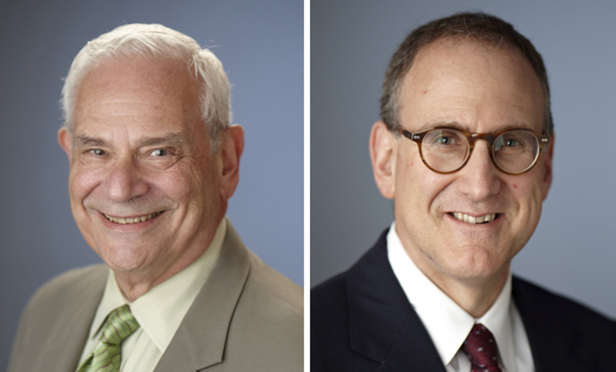Hub, Spokes and Rim: Revisiting 'Kotteakos'
In their White-Collar Crime column, Elkan Abramowitz and Jonathan Sack discuss the college admissions scandal in the context of "Kotteakos v. United States," which held that a conspiracy requires interdependence among its members.
May 06, 2019 at 11:00 AM
11 minute read
 Elkan Abramowitz and Jonathan Sack
Elkan Abramowitz and Jonathan Sack
A conspiracy charge is a powerful tool of the prosecution in a federal criminal case. A conspiracy charge allows prosecutors to combine many defendants and alleged criminal acts in one indictment so long as they are generally linked to a common criminal purpose, or purposes. Alleging a conspiracy also expands the scope of admissible evidence by permitting the government to introduce acts and statements of conspirators against one another under relatively relaxed standards of admissibility. The impact can be substantial. In a multi-defendant trial, it is harder to portray a defendant as an individual, and not simply a member of a group, and it is harder to separate the evidence against one individual from the evidence against others.
Federal law has recognized limits on the proper scope of a conspiracy. One of the most important limits was expressed more than 70 years ago in Kotteakos v. United States, 328 U.S. 750 (1946), which addressed “hub and spoke” conspiracies, in which defendants (like “spokes”) are linked to another individual (a “hub”) but not to one another (without a “rim”). In such cases, defendants would be part of separate conspiracies, not a single overarching conspiracy, despite committing the same or similar substantive offenses. If a single conspiracy is charged when the facts support only multiple conspiracies, a number of risks follow, including reversal of a conviction due to the admission of evidence that should not have been admitted in a properly charged conspiracy, as happened in Kotteakos.
This issue—single versus multiple conspiracies—has recently surfaced in the government's prosecution of an alleged “nationwide college admissions scam.” Press Release, Arrests Made in Nationwide College Admissions Scam, U.S. Dep't of Justice (March 12, 2019). In that case, the government has accused parents of conspiring to pay bribes, cheat on college entrance exams, and submit falsified information about athletic abilities. Beyond the splashy headlines, the case raises the significant legal issue of the proper scope of a criminal conspiracy: may an alleged fraud scheme involving numerous individuals—who interacted with a single common co-conspirator—be charged as a single conspiracy?
In this article, we begin with a discussion of Kotteakos, which held that a conspiracy requires interdependence among its members. Then we discuss the indictment in the college admissions scandal, in which 19 parents have been charged with a single conspiracy to commit mail and wire fraud and money laundering. We conclude by analyzing defense arguments that, under Kotteakos, the government should have charged the 19 parents with separate conspiracies.
Interdependence Requirement
In Kotteakos, the government charged 32 defendants with a single conspiracy to violate a New Deal-era law which sought to increase the availability of affordable loans to home buyers. In a prosecution eerily similar to cases that arose from the recent financial crisis, the defendants worked with a “common and key figure,” Simon Brown, who helped broker government guaranteed loans for the defendants that he knew “were not to be used for the purposes stated in the applications.” 328 U.S. at 753. Brown pled guilty and became a cooperating witness for the government, testifying about the falsification of loan documents submitted on behalf of each of the defendants. Id. at 755 n.6.
The government acknowledged that the “defendants did not have any relationship with one another, other than Brown's connection with each transaction”—i.e., the evidence “proved not one conspiracy, but some eight or more different ones of the same sort executed through a common key figure.” Id. at 753, 754. The court described the conspiracy as a “wheel” with “separate spokes meeting at a common center, though … without the rim of the wheel to enclose the spokes.” Id. at 755. Of the 32 defendants charged, 13 went to trial, which resulted in two acquittals and seven guilty verdicts, with the jury hung as to the remaining four defendants. Id. at 753.
On appeal, the U.S. Court of Appeals for the Second Circuit held that although the trial court erroneously concluded that the evidence supported a single conspiracy, the trial court's error was harmless. Id. at 755. The Supreme Court disagreed and reversed the convictions, holding that it was prejudicial to join in the same conspiracy “different persons who did not know or have anything to do with one another.” Id. at 758.
In concluding that reversal was warranted, the court distinguished the facts in Kotteakos from its earlier opinion in Berger v. United States, 295 U.S. 78 (1935). In Berger, a jury convicted a defendant on a single count of conspiracy to counterfeit money. The evidence at trial, however, proved the existence of two separate counterfeiting conspiracies involving four defendants in total, with the “only connecting link between the two [being] that [one defendant] was in both conspiracies and the same counterfeit money had to do with both.” Id. at 79. Given the small number of defendants and the existence of only two distinct conspiracies, the Supreme Court held in Berger that any variance in the proof submitted at trial “was not prejudicial and hence not fatal.” Id. at 84. The Berger court cautioned, however, that proof of multiple conspiracies could be a material variance under different circumstances. Id. at 83-84.
In Kotteakos, the court held that because the government charged one conspiracy “but eight separate ones were proved, involving at the outset thirty-two defendants,” the “sheer difference in numbers” distinguished the case from Berger. 328 U.S. at 766. The court emphasized that criminal guilt “remains individual and personal, even as respects conspiracies,” and “is not a matter of mass application.” Id. at 772. Noting the difficulty of defending a case that alleged so many separate transactions by 32 unconnected “spokes,” the court addressed the possible “psychological effect” of guilt by association “in spite of instructions [to the jury to] keep[ ] separate transactions separate.” Id. at 767. Accordingly, the court held that the government may not “string together, for common trial, eight or more separate and distinct crimes, conspiracies relating in kind though they may be, when the only nexus among them lies in the fact that one man participated in all.” Id. at 773.
Applying Kotteakos, the Second Circuit has held that in order to prove a single conspiracy, prosecutors must introduce evidence of “interdependence” among the conspiracy's participants. “[T]he government must show that each alleged member agreed to participate in what he knew to be a collective venture directed toward a common goal.” United States v. Berger, 224 F.3d 107, 114 (2d Cir. 2000).
In multi-defendant cases, courts have used the concept of a “chain” conspiracy to distinguish a proper single conspiracy from an overbroad “hub and spoke” conspiracy. In a chain conspiracy, multiple “links” are said to depend upon one another for success. In drug-trafficking cases, for example, “a chain may be comprised of producers, exporters, wholesalers, middlemen, and dealers,” each of whom “must know that combined efforts are required” for the conspiracy to succeed, United States v. Ulbricht, 31 F. Supp. 3d 540, 553-54 (S.D.N.Y. 2014). A single conspiracy may be charged even when its members do “not know the identities of all of the other conspirators, nor all of the details of the conspiracy …, nor specifically know of one another's involvement.” United States v. Sureff, 15 F.3d 225, 230 (2d Cir. 1994).
The College Admissions Case
In the college admissions case, a grand jury returned an indictment charging 19 parents with a single conspiracy to commit mail and wire fraud and money laundering. See Second Superseding Indictment, United States v. Sidoo, No. 19-cr-10080, ECF No. 314 ¶¶ 322-23 (D. Mass. April 9, 2019). The indictment alleges that the parents independently worked with Rick Singer—the founder of a college counseling and preparation business—to gain their children's admission to elite colleges and universities through fraudulent means. The parents allegedly paid Singer to (a) facilitate cheating on college entrance exams; (b) bribe collegiate athletic coaches and administrators to designate applicants as athletic recruits; (c) have third parties take classes in place of the actual students; and (d) submit falsified admissions applications that included fraudulently obtained test scores and class grades, as well as fake awards and athletic activities. Id. ¶61.
The alleged illegal acts took place between 2011 and 2019. Id. ¶¶ 64-71, 106, 268. The indictment does not allege that the parents knew of or worked with each other—e.g., by referring one another to Singer. See generally id. ¶¶64-321. Rather, the indictment alleges that “the defendants conspired with others known and unknown to the Grand Jury to use bribery and other forms of fraud to facilitate their children's admission to selective colleges and universities in the District of Massachusetts and elsewhere.” Id. ¶60.
Defense Arguments
Two parents (the Colburns) recently filed a motion to dismiss the indictment, arguing under Kotteakos that the government impermissibly charged a single “'rimless hub and spokes' conspiracy where Singer and his associates are the 'hub' of the wheel, and the parents … are the 'spokes.'” Sidoo, No. 19-cr-10080, ECF No. 341 at 7 (D. Mass. April 15, 2019). The indictment alleges that the Colburns paid Singer $25,000 to have a third party pose as a proctor for their son's SAT exam and secretly correct his answers. Id., ECF No. 314 ¶ 87. They argue that the indictment's allegations fail to establish the necessary interdependence among the conspiracy's numerous alleged participants.
Movants note that they are accused of using one of the “methods” of the alleged scheme—having a proctor secretly change exam answers—but not others: having a third party take an exam in a student's place, or bribing collegiate athletic coaches to designate a student as an athletic recruit. Movants emphasize that the indictment does not contain allegations that they knew of or participated in other parents' similar schemes. They also point out that the various alleged schemes in the indictment “were often separated by years and occurred across the country.” Id., ECF No. 341 at 7.
Thus, it would be unfairly prejudicial, according to movants, to charge them with a single conspiracy when most of the other 17 parents operated separately and were concerned only with seeking the admission of their own children. Drawing parallels to Kotteakos, the Colburns argue that although Singer is the one central figure in each of the parents' separate schemes, “the parents' circumstances are each unique and personal, and their alleged schemes are not interdependent.” Id. at 10.
Prejudice to the defense from a single conspiracy charge could arise at trial in various ways. For example, each parent likely would want to impeach testimony given by the government's cooperating witness, Singer, and highlight any gaps in the evidence concerning a given defendant's acts or mental state. That approach may be more difficult, however, if the government's witnesses are, in effect, corroborated by evidence against totally unrelated codefendants. In the same vein, one defendant might be hard pressed to argue he or she did not fully understand the scheme if the government has marshaled stronger evidence as to other similarly situated defendants. In short, it will likely be very difficult to avoid the “guilt by association” effect expressed by the Supreme Court in Kotteakos.
The government's responsive papers are due in late July.
Conclusion
Charging a conspiracy is a powerful prosecutorial tool but one that can produce unfairness. If unchecked, an overbroad conspiracy charge can lead to a trial in which individuals who did not enter into an agreement to commit a crime are tried together and thus subjected to unfair prejudice. The Supreme Court articulated this fundamental principle of due process in Kotteakos. The vitality of that decision and the principles underlying it may be tested in one of the most high-profile white-collar prosecutions in recent years.
Elkan Abramowitz and Jonathan Sack are members of Morvillo Abramowitz Grand Iason & Anello. Mr. Abramowitz is a former chief of the criminal division in the U.S. Attorney's Office for the Southern District of New York. Mr. Sack is a former chief of the criminal division in the U.S. Attorney's Office for the Eastern District of New York. Justin Roller, an associate of the firm, contributed to this article.
This content has been archived. It is available through our partners, LexisNexis® and Bloomberg Law.
To view this content, please continue to their sites.
Not a Lexis Subscriber?
Subscribe Now
Not a Bloomberg Law Subscriber?
Subscribe Now
NOT FOR REPRINT
© 2025 ALM Global, LLC, All Rights Reserved. Request academic re-use from www.copyright.com. All other uses, submit a request to [email protected]. For more information visit Asset & Logo Licensing.
You Might Like
View All
Parties’ Reservation of Rights Defeats Attempt to Enforce Settlement in Principle
11 minute read


Trending Stories
- 1How Alzheimer’s and Other Cognitive Diseases Affect Guardianship, POAs and Estate Planning
- 2How Lower Courts Are Interpreting Justices' Decision in 'Muldrow v. City of St. Louis'
- 3Phantom Income/Retained Earnings and the Potential for Inflated Support
- 4Should a Financially Dependent Child Who Rejects One Parent Still Be Emancipated?
- 5Advising Clients on Special Needs Trusts
Who Got The Work
J. Brugh Lower of Gibbons has entered an appearance for industrial equipment supplier Devco Corporation in a pending trademark infringement lawsuit. The suit, accusing the defendant of selling knock-off Graco products, was filed Dec. 18 in New Jersey District Court by Rivkin Radler on behalf of Graco Inc. and Graco Minnesota. The case, assigned to U.S. District Judge Zahid N. Quraishi, is 3:24-cv-11294, Graco Inc. et al v. Devco Corporation.
Who Got The Work
Rebecca Maller-Stein and Kent A. Yalowitz of Arnold & Porter Kaye Scholer have entered their appearances for Hanaco Venture Capital and its executives, Lior Prosor and David Frankel, in a pending securities lawsuit. The action, filed on Dec. 24 in New York Southern District Court by Zell, Aron & Co. on behalf of Goldeneye Advisors, accuses the defendants of negligently and fraudulently managing the plaintiff's $1 million investment. The case, assigned to U.S. District Judge Vernon S. Broderick, is 1:24-cv-09918, Goldeneye Advisors, LLC v. Hanaco Venture Capital, Ltd. et al.
Who Got The Work
Attorneys from A&O Shearman has stepped in as defense counsel for Toronto-Dominion Bank and other defendants in a pending securities class action. The suit, filed Dec. 11 in New York Southern District Court by Bleichmar Fonti & Auld, accuses the defendants of concealing the bank's 'pervasive' deficiencies in regards to its compliance with the Bank Secrecy Act and the quality of its anti-money laundering controls. The case, assigned to U.S. District Judge Arun Subramanian, is 1:24-cv-09445, Gonzalez v. The Toronto-Dominion Bank et al.
Who Got The Work
Crown Castle International, a Pennsylvania company providing shared communications infrastructure, has turned to Luke D. Wolf of Gordon Rees Scully Mansukhani to fend off a pending breach-of-contract lawsuit. The court action, filed Nov. 25 in Michigan Eastern District Court by Hooper Hathaway PC on behalf of The Town Residences LLC, accuses Crown Castle of failing to transfer approximately $30,000 in utility payments from T-Mobile in breach of a roof-top lease and assignment agreement. The case, assigned to U.S. District Judge Susan K. Declercq, is 2:24-cv-13131, The Town Residences LLC v. T-Mobile US, Inc. et al.
Who Got The Work
Wilfred P. Coronato and Daniel M. Schwartz of McCarter & English have stepped in as defense counsel to Electrolux Home Products Inc. in a pending product liability lawsuit. The court action, filed Nov. 26 in New York Eastern District Court by Poulos Lopiccolo PC and Nagel Rice LLP on behalf of David Stern, alleges that the defendant's refrigerators’ drawers and shelving repeatedly break and fall apart within months after purchase. The case, assigned to U.S. District Judge Joan M. Azrack, is 2:24-cv-08204, Stern v. Electrolux Home Products, Inc.
Featured Firms
Law Offices of Gary Martin Hays & Associates, P.C.
(470) 294-1674
Law Offices of Mark E. Salomone
(857) 444-6468
Smith & Hassler
(713) 739-1250






